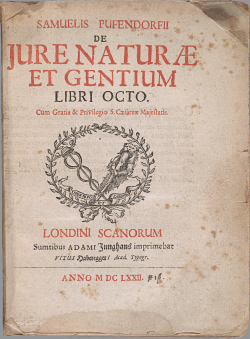 Samuel, Freiherr von Pufendorf, De Jure Naturae et Gentium Libri Octo (London: Sumtibus Adami Junghans, imprimebat Vitus Haberegger, 1672).
Samuel, Freiherr von Pufendorf, De Jure Naturae et Gentium Libri Octo (London: Sumtibus Adami Junghans, imprimebat Vitus Haberegger, 1672). Tinted glass slide depicting the Great Sphinx of Giza (circa 1900).
Tinted glass slide depicting the Great Sphinx of Giza (circa 1900).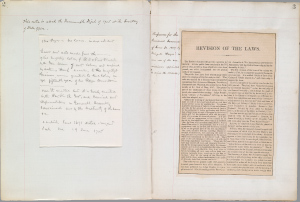 Sidney S. Rider, compiler, Bibliography of Rhode Island (Manuscript with clippings, short publications, etc.).
Sidney S. Rider, compiler, Bibliography of Rhode Island (Manuscript with clippings, short publications, etc.).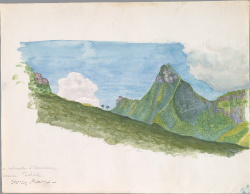 Henry Adams, Memoirs of Marau Taaroa, Last Queen of Tahiti (Privately printed, 1893).
Henry Adams, Memoirs of Marau Taaroa, Last Queen of Tahiti (Privately printed, 1893).Several important book collections were given to the library at the turn of the 20th century. Among the most significant was the Wheaton Collection on International Law, given by William V. Kellen, Class of 1872. The collection, named in honor of Henry Wheaton, Class of 1802, a major figure in the field of international law, contained many important books, particularly early editions of Grotius and Pufendorf.
The Lysander Dickerman Collection on Egyptology arrived as the new century began. Dickerman, Class of 1851, a Congregationalist minister and avid amateur archaeologist, bequeathed 1,200 books on ancient Egypt, along with his papers and glass slide collection, establishing the foundation for Brown’s exceptional holdings in the field of Egyptology.
The Sidney S. Rider Collection on Rhode Island history, the largest private collection of early Rhode Island material ever assembled, was purchased and presented to the library in 1903 by Marsden J. Perry. Rider, a leading Providence bookseller and antiquarian, had amassed his collection of books, pamphlets, manuscripts, broadsides, and newspapers over 50 years. Perry, Providence’s leading financier and an important collector in his own right, recognized the importance of the Rider Collection for future scholarship and presented it to Brown.
In 1903, the University began, for the first time, to systematically collect the records of its own history. Clarence S. Brigham, Librarian of the Rhode Island Historical Society and later Director of the American Antiquarian Society, was retained as Archivist to locate, classify, and arrange early college documents. Under Brigham’s direction, an Archives room was established although rarer items were placed in the more secure Harris Room.
In July of 1905, John Hay, Class of 1858, perhaps the most famous Brown graduate of his day, died in office as U.S. Secretary of State. The following year his widow, Clara Stone Hay, presented 400 books and manuscripts from Hay’s personal library to Brown. These books, still maintained as a separate collection, contain many volumes which are inscribed to John Hay.
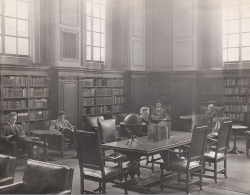 John Hay Library (Built 1908–1910).
John Hay Library (Built 1908–1910).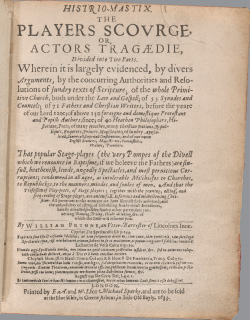 William Prynne, Histrio-Mastix: The Players Scourge, or Actors Tragedie (London: Printed by E. A. and W. I. for Michael Sparke, 1633).
William Prynne, Histrio-Mastix: The Players Scourge, or Actors Tragedie (London: Printed by E. A. and W. I. for Michael Sparke, 1633).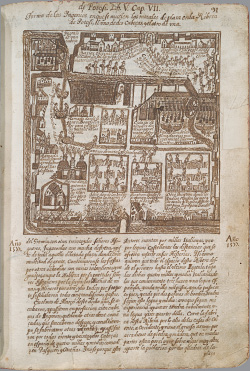 Bartolomé Arzans de Orsua y Vela, Historia de la Villa Imperial de Potosí (Potosí, Bolivia: early 18th century).
Bartolomé Arzans de Orsua y Vela, Historia de la Villa Imperial de Potosí (Potosí, Bolivia: early 18th century).By the early 1890s, the library had so little room for books that lesser used materials had to be stored in the basement. Repeated requests for a new library were unavailing until 1906, when Andrew Carnegie contributed $150,000 toward a new library building honoring his late friend, John Hay. A matching amount was raised, ground was broken in 1908, and the new building was dedicated in November, 1910. Designed in the English Renaissance style by the eminent Boston architectural firm of Shepley, Rutan and Coolidge, the John Hay Library accommodated 180 readers and 300,000 volumes. As described in the President’s report of 1909, there were “separate and convenient rooms for the great special collections of the library, the Harris Collection of American Poetry, the Rider Collection of Rhode Island History, and the Wheaton Collection of International Law, besides proper shelving for art books, rare books, and pamphlets.”
Harry Lyman Koopman, University Librarian from 1893 to 1930, spent most of the summer of 1910 supervising the transfer of books from the old library, now Robinson Hall, to the newly constructed John Hay Library. The Reading Room opened, with the reference collection in place, on September 24, the first day of the fall term. Relocation of 140,000 stack books began in October and was completed by November 11, when the library was officially dedicated.
Soon after the John Hay Library dedication, the personal library of the late Hammond Lamont, Professor of Rhetoric from 1895 to 1900, was donated to the University as a memorial from his students in the Classes of 1899 and 1900. These 2,700 volumes of 17th–18th century English literature included many works by Daniel DeFoe and William Prynne, including the latter’s Histrio-Mastix (London, 1633).
Colonel George Earl Church, commander of a Rhode Island regiment during the Civil War, spent most of his later life as an explorer and engineer in South America. In 1912, his personal library of over 3,500 volumes of economic, historic, geographic, and descriptive studies of South America was received by the library. Many of these books are rare even in South American libraries. Perhaps the most important item in the collection is an 18th century manuscript history of the Bolivian mining town of Potosí, once the largest city in the New World.
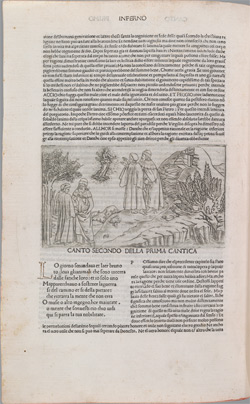 Dante Alighieri, La Comedia (Florence: Nicholo di Lorenzo della Magna, 1481).
Dante Alighieri, La Comedia (Florence: Nicholo di Lorenzo della Magna, 1481).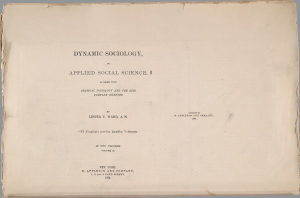 Lester Frank Ward, proof page F from Dynamic Sociology (New York: Appleton, 1883).
Lester Frank Ward, proof page F from Dynamic Sociology (New York: Appleton, 1883).The Church Collection was joined by two others in 1912. The first consisted of over 1,700 books and rare pamphlets, dating from the 16th to the 20th centuries, relating to the works of Dante. It was formed by William Henry Chambers, an English scholar living in Florence, and purchased from his heirs by Professor Courtney Langdon with funds donated by Henry D. Sharpe, Class of 1894. Professor Langdon’s own heavily annotated collection was appended to the Chambers Collection in 1925.
The second collection was a group of more than 2,000 American ballads, most of Civil War vintage, from Frank E. Bliss, Class of 1868. These became the foundation of the Broadsides Collection which now numbers over 60,000 items.
Professor Lester Frank Ward, recognized today as one of the founders of the field of sociology, donated his library and personal papers in 1914. These 1,200 bound volumes and pamphlets, plus several thousand letters and manuscripts, represent Ward’s interests in botany, paleobotany, geology, philosophy, and sociology. A collection of 1,000 volumes in Icelandic, Pali, and Sanskrit formerly belonging to Dr. Adrian Scott, Class of 1872, was also presented in that year by his classmates, as was a copy of William Penn’s Select Works (London, 1771), presented by members of the Herreshoff family.